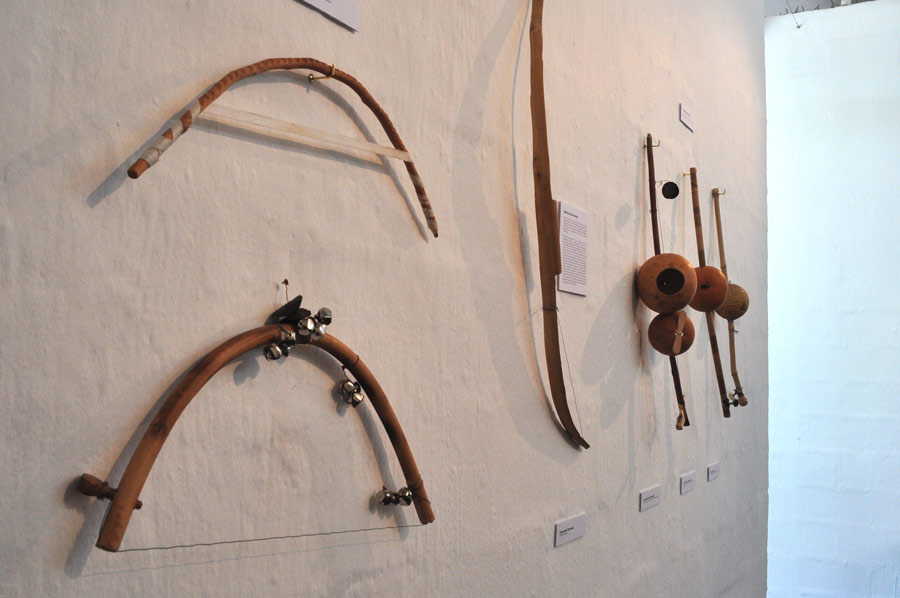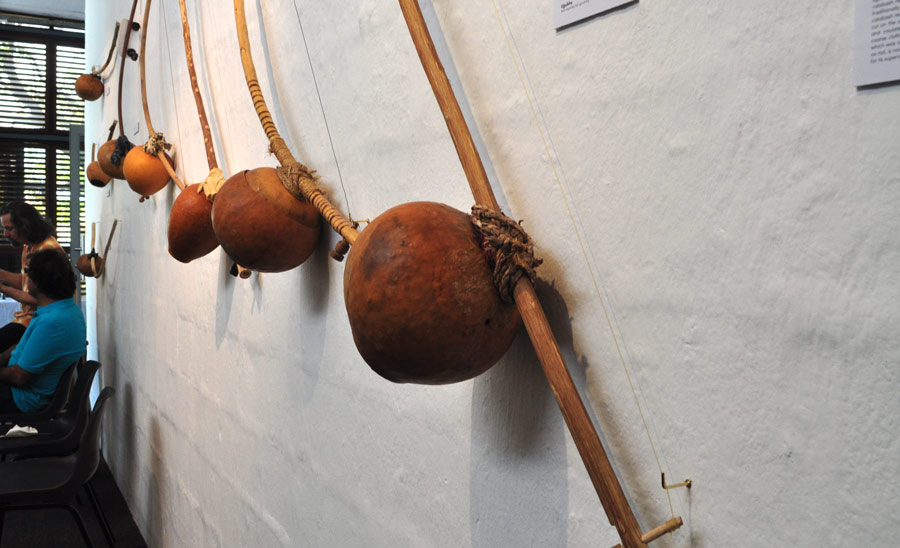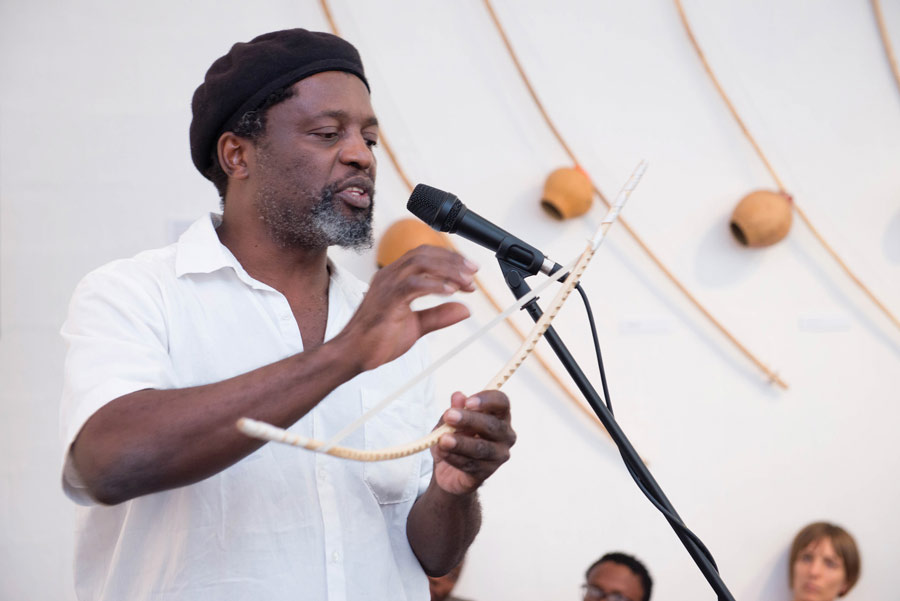In Africa south of the equator, musical bows are among the most pervasive of indigenous musical instruments. Their ubiquity confirms past cultural convergences between disparate early pastoral, agrarian and hunter-gatherer African societies. In the south and eastern parts of southern Africa, members of several ethnic groups render diverse musical repertoires from a variety of single-string bows. The Shangane, the Swazi, the Tsonga, the Thonga, Zulu and the Xhosa of the southernmost east African coast, the Khoi, and San are such contemporary African societies who still retain varying degrees of engagement with bow musical performance. Musical bows, because of their naturally low resonance levels, normally employ resonators of one kind or another – often of gourd /calabash material, or more recently metal (tin or zinc).
Wind bows
A number of wind bows were found distributed among various Southern African indigenous musical cultures. Among these were the gora (Korana), Bakgatla (Tswana) kwadi, the Sotho lesiba, the Cape San //ha, Shangane zambi, the Venda tshizambi, the Xhosa ugwali, and the Zulu /Venda ugwala.
Unbraced mouth-bows
In 1931, Kirby found among the Xhosa-Pondo (Bantu) of Nqamakwe in the eastern Cape Province, a specimen of inkinge unbraced mouth-bow, described as being,
‘Made of a river-reed, with a string of twisted hair [possibly ox or horse-tail]. It is 2’9.5” long and 0.7” in diameter. Two V-shaped notches in the one end where the string is wound. The string is plucked by a thorn (De Lange 1967:70)
The description above usefully approximates that of another unbraced non-friction umqunge mouth bow of the Pondo-Xhosa of the eastern Cape. Versions of the same instrument, with slight variations in design, materials and playing technique were similarly documented among non-Nguni (non-Eastern seaboard!) Bantu and Korana-Khoi societies. The Sotho, Pedi lekope, the Tswana lengope, the Venda lugube and the Korana !gabus all seem to describe a variant of essentially the same type of unbraced mouth-bow. There also existed a Swazi utiyane friction mouth bow, nearly two feet long and just over an inch in diameter, made out of a hollowed-out branch of umsenge tree and which, in order to produce sound, was scraped by a player using a corn stalk. Two types of unbraced mouth bows, namely the Xhosa umrhubhe friction mouth-bow and the umqangala of the Swazi, Thonga and Zulu societies are still relatively commonly used.

Braced mouth-bows
Braced mouth bows were normally of non-friction type, such as the tshigwana or tshivhana (Venda), the sekgapa of the Thonga, the lekope of the Pedi, the setolotolo composite mouth bow of the Sotho, and the isitontolo of the Ndebele, Swazi and Zulu. Displayed is the Tsonga chipendane mouthbow.
Umqangala and Umrhubhe mouth-bows
Umrhubhe makers prefer using a lighter wood, or a well-seasoned cane, for fashioning the intonga stick of approximately a metre-and-a-half in length. The cut sapling is first debarked and bent into a bow-shape (a piece of string, hide or wire may be employed). The string used is often brass-wire, although formerly a string was woven from twisted strands of hair from an ox-tail. Makers of the their own instruments such as the legendary umrhubhe player Madosini Mpahleni prefer using ideal materials such as umbangandlala tree for fashioning the bow stave. For string, the brass-bangle umliza wire is prepared by heating and straightening it. When making umqangala, Minah Mkhize of Ndumu/Maputaland (northern-eastern KwaZulu-Natal) uses umhlanga reed for stave and nylon fishing line (sizes 1 or 2) for the usinga string. It is important that the players make their own instrument since material, design and construction considerations ultimately determine the ideal sound quality produced as well as the optimum usability of the instrument.
Mouth-resonated musical bows
Mouth-resonated musical bows belong to a group of bows which use harmonics of a vibrating string to execute a melody while simultaneously generating fundamental pitches that function as a ‘bass’ or chorus part. Such bows are found in use by several ethnic societies often separated by vast geographic distances. Among other traits, mouth-resonated bows may be distinguished by characteristics in their design such as appearance, handling or method by which sound is produced. Some of the mouth-resonated bows found in the SADC region and ethnic groups associated with their use include:
Braced bows with calabash resonators
Eg. Umakhweyana (Zulu & Swati) is only one of several types of bows that are commonly found (although differently named) among the northern Nguni (Zululand, Swaziland), the Thonga and Chopi of Mozambique. Although some men also played, makhweyana was traditionally played by young unmarried women, adolescent girls of courting age. After marriage women often had to stop playing because of other responsibilities of the homestead and married life. In size umakhweyana bow varies from between 1m to 1,5 m in length, the larger bows being usually played by men and the smaller sizes played by women. It is made out of a de-barked seasoned, light and resonant tree-branch, such as uthathawe. There are other suitable plant species for makhweyana staves, among these are iphahla and umbangandlala trees. The bow has a resonator attached to the middle of the stave, using a loop of string. To the two ends of the stave is attached a length of wire, usually made out of an unwound bangle. This length of wire is divided into two sections, and tensioned by a loop that also binds the calabash to the stave.

Unbraced bows with calabash resonators
Eg. uhadi (Xhosa), ugubhu/ligubhu (Zulu/Swati) Mostly played by women and girls normally in the evenings, although musical male youth occasionally take it up. Injikwe or intonga (stave) is normally made of mbangandlala tree. Originally made of twisted ox-sinew, cow or horse hair, nowadays usinga (string) is often a thin-gauge, preferably an unravelled umliza (brass-bangle) wire. Normally umqunge (tambootie grass) or umcinga (wheat-straw) is used as a beater. Iselwa (calabash resonator) is attached approximately two-thirds along the length of the stave to one end. Ugubhu is another familiar calabash-resonated, unbraced mono-heterochords in use among the northern Nguni-Bantu of eastern South Africa. The largest of Nguni musical bows, ugubhu measures approximately 1,5 metres long with a calabash resonator attached near the lower end. The bow is traditionally made from a debarked tree branch. The calabash resonator has a circular hole of 50-70mm diameter cut on the side opposite the stalk. The resonator is attached and insulated from the stave using a pad of bark, grass, coarse cloth, a piece of hide or similar material. The string, which was originally made of twisted strands of hair from an ox-tail, is nowadays made of wire, brass wire being preferred for its superior resonant quality.


